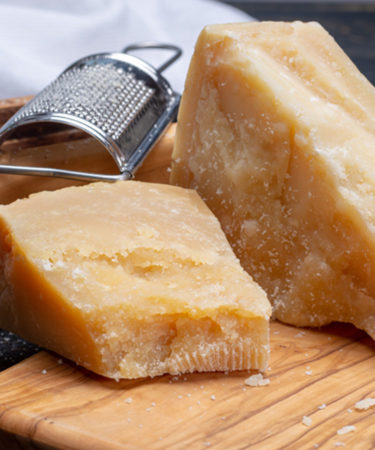
While we often use the name “parmesan” to refer to all of Italy’s grateable hard cheeses, there are a number of different styles within the category. Parmesan is one of them, though that particular cheese isn’t necessarily as closely linked to Italy as you might imagine.
Grana Padano, Parmigiano-Reggiano, and Pecorino Romano are others to consider. Each has “Protected Designation of Origin” (DOP) status under E.U. law, and their producers have strict geographical boundaries and aging guidelines to follow, impacting the flavor and price of their products.
So before you head out to the grocery store, or even think about picking up that grater, get to know the different styles of Italian hard cheeses.
Parmesan
According to FDA laws, any cow’s milk cheese that has a hard, brittle rind and granular texture, and grates easily, can be labeled parmesan in the U.S. The cheese’s origin plays no part in labeling laws, so producers from Idaho are just as free to use the term parmesan as those importing cheese from Italy.
Not only does a hard cheese not need to come from Italy to be classified as parmesan, it doesn’t even need to be made from fresh whole milk. Instead, reconstituted dry milk, skim milk, and/or cream are also all acceptable.
Parmigiano-Reggiano
Parmigiano-Reggiano is the style most of us think we’re referring to when using the name parmesan. It’s the highest quality of all Italian hard cheeses, and the one locals refer to as “The King of Cheeses” — just don’t tell the Roquefort-loving French.
To comply with DOP guidelines, Parmigiano-Reggiano has to be made in one of two northern Italian regions: Emilia-Romagna, which is home to Parma (hence the name), or the Mantova province of Lombardy.
The 100-percent cow’s milk cheese must age for a minimum of one year, though periods regularly extend to 18, 24, and even 36 months. At this point, Parmigiano-Reggiano is ready for official inspection. If it passes, the cheese’s name, production date, and a DOP seal are stamped into its hard, umami-rich rind.
Grana Padano
Like Parmigiano-Reggiano, Grana Padano is a golden, hard-rind cheese made using cow’s milk. The production region is much larger than that of the King of Cheeses, and, at nine months, the minimum aging requirement is more relaxed.
As a result, Grana Padano has a slightly sweeter, less-concentrated flavor than Parmigiano-Reggiano. It is also more affordable.
Pecorino Romano
Pecorino Romano is texturally similar to the other three kinds of cheese, but that’s where their similarities end.
Rather than cows, it’s sheep that provide milk for Pecorino Romano. Aging ranges between five months and eight months, and Pecorino Romano production must occur either on the island of Sardinia (where the majority takes place), in the central region of Lazio, or in the Tuscan province of Grosseto.
Although it ages for shorter periods, Pecorino Romano carries a stronger flavor profile and is saltier and tangier than Parmigiano-Reggiano. These bold flavors come from the sheep’s milk base, which also provides a milky white cheese and a dark black rind, compared to the yellow-golden cow’s milk alternatives.
